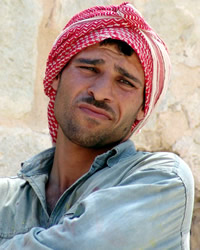Arab, Syrian in West Bank / Gaza

Photo Source:
James Gordon - Wikimedia
Creative Commons
|
Send Joshua Project a map of this people group.
|
| People Name: | Arab, Syrian |
| Country: | West Bank / Gaza |
| 10/40 Window: | Yes |
| Population: | 16,000 |
| World Population: | 23,523,800 |
| Primary Language: | Arabic, Levantine |
| Primary Religion: | Islam |
| Christian Adherents: | 5.00 % |
| Evangelicals: | 0.10 % |
| Scripture: | New Testament |
| Ministry Resources: | Yes |
| Jesus Film: | Yes |
| Audio Recordings: | Yes |
| People Cluster: | Arab, Levant |
| Affinity Bloc: | Arab World |
| Progress Level: |
|
Introduction / History
Syrian Arabs in the West Bank are a small but historically significant group, primarily linked to migration during the Ottoman and British Mandate periods. Syria and Palestine were once part of the Greater Syria region (Bilad al-Sham) under Ottoman rule, allowing movement between present-day Syria, Lebanon, Jordan and Palestine. During the early 20th century, some Syrians migrated to the West Bank for trade, work or political reasons, particularly after the collapse of the Ottoman Empire and the establishment of the British Mandate.
Following the 1948 Arab-Israeli War (Nakba) and later conflicts, additional Syrian individuals arrived in the region, though in smaller numbers compared to Palestinian refugees. While they have largely integrated into Palestinian society, many still identify with their Syrian heritage, maintaining linguistic and cultural ties. Today, Syrian Arabs in the West Bank share the same challenges as Palestinians, including political instability, restricted movement, and economic difficulties, while also preserving aspects of their unique background.
What Are Their Lives Like?
Syrian Arabs in the West Bank live much like the broader Palestinian population, facing similar economic, social and political challenges. Many have fully integrated into Palestinian society, working in sectors like agriculture, trade, construction and public services. While some still identify with their Syrian heritage, their daily lives are shaped by the realities of the Israeli-Palestinian conflict, including restricted movement, economic hardship and political uncertainty.
Like other West Bank residents, they face high unemployment rates and rely on local businesses or work in Israel when permits are available. Due to economic conditions and regional instability, access to healthcare, education and housing remains limited. Socially, they maintain strong family and community ties, celebrating Palestinian and Syrian cultural traditions. While some may have retained connections with relatives in Syria, ongoing conflict there has made travel and communication difficult.
What Are Their Beliefs?
The majority of Sukuma people practice and are deeply rooted in animism. Every area of life, from naming their children to planting crops, is affected by their belief in the ancestral and other spirits. The Sukuma are presently about 42% Christian, and that number has been growing significantly in recent years. However, there is still a lot of syncretism with animism in Christianity.
What Are Their Needs?
The Sukuma people in rural areas are especially poor, but they are able to meet their own subsistence needs. However, when drought comes to this dry savannah region, this area is hit especially hard.
The Sukuma also have a spiritual need – to be free
Prayer Points
Pray for the Lord's blessing of Syrian Arabs spiritually and psychologically.
Pray for Syrian Arab believers to be blessed with peace and joy in the Holy Spirit in such a way they can reach out to others who suffer from psychological trauma and loss.
Pray for Syrian Arabs to be open to the blessings of Jesus Christ and his way of salvation through grace.
Pray for a movement to Christ among Syrian Arabs wherever they live.